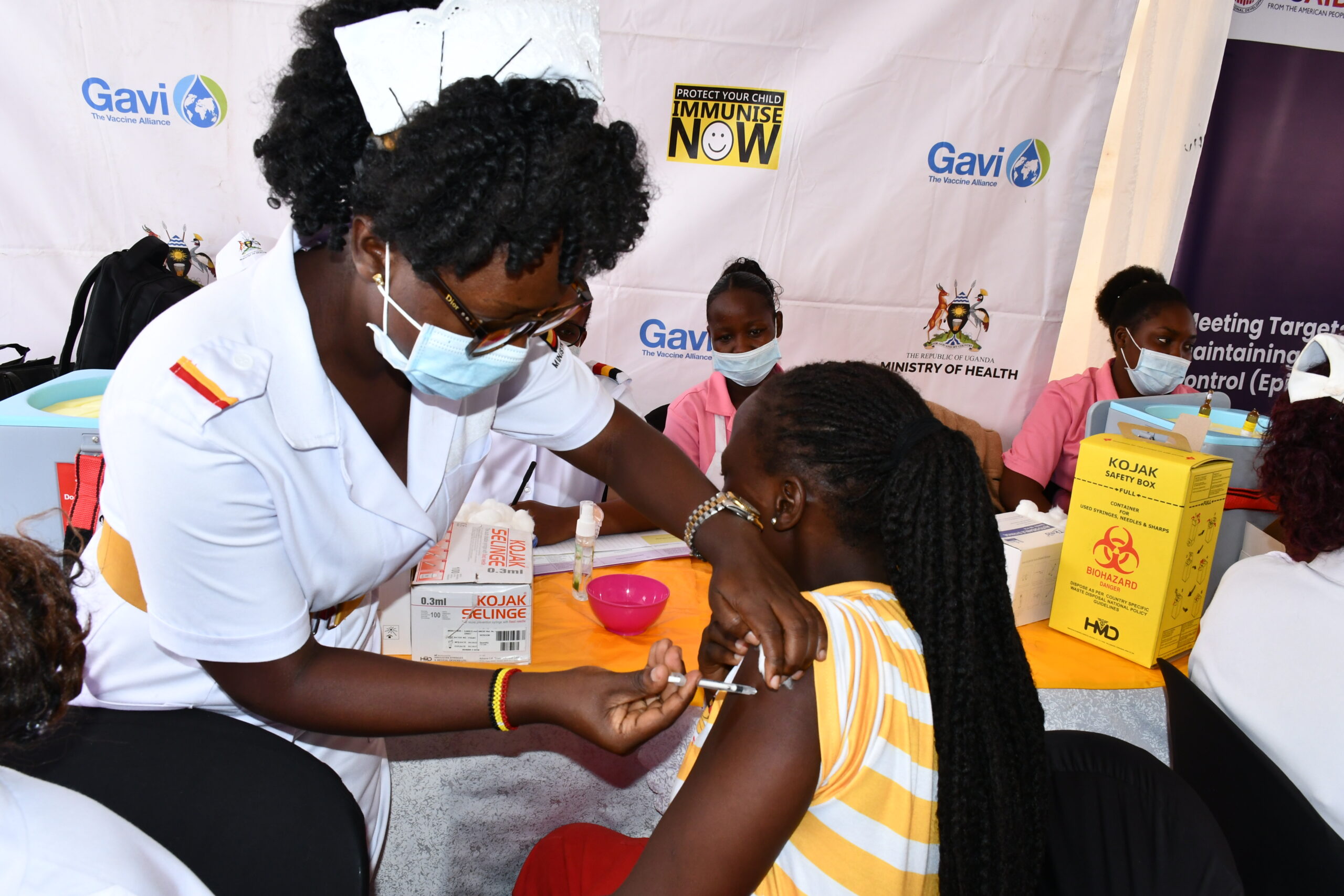Developing a COVID-19 Vaccination Integration Strategy in Uganda
Developing a COVID-19 Vaccination Integration Strategy in Uganda
Published on July 12, 2023

This post explores the integration of COVID-19 vaccination within leadership and governance through the development of a Vaccination Integration Strategy in Uganda.
About this blog series
Emergency funding for COVID-19 has begun to shift towards activities that integrate the COVID-19 vaccine into life course vaccination programs within the primary health care (PHC) system. Governments, donors, and program implementers are building on lessons learned from COVID-19 to build resilient health systems that can accommodate new vaccines and withstand future pandemics. Identifying ways to integrate COVID-19 vaccination activities into standard primary health care services, USAID and WHO have shared guidance to assist countries with this integration process.
Leadership & governance
This is the third in a series of seven blog posts highlighting examples and lessons learned regarding the integration of COVID-19 into primary health care. Read the other posts in the series for more about COVID-19 vaccination integration and examples from other health areas.
The global USAID-funded Meeting Targets and Maintaining Epidemic Control (EpiC) project provides technical assistance and service delivery to control the HIV epidemic and promote self-reliant management of national HIV programs by improving HIV case finding, prevention, and treatment programming. In 2020, the EpiC scope was modified to include COVID-19 programming in 56 countries. In Uganda, EpiC supported the Ministry of Health to respond to the COVID-19 pandemic, including roll-out of vaccines.
The EpiC Uganda team has been working with the country’s Ministry of Health, supporting COVID-19 vaccination as part of the wider COVID-19 pandemic response. We talked with Dr. Possy Mugyenyi, EpiC Uganda Technical Director, about their experience working with stakeholders to develop a national integration strategy.
What was the impetus for developing a COVID-19 vaccination integration plan for routine immunization?
During the first stage of the pandemic, national campaigns in Uganda did a great job of increasing the uptake of the COVID-19 vaccine’s first dose from 15% to over 80%. It was, however, observed that the campaigns were not sustainable. They were very expensive and caused disruptions in the provision of health care services, as health workers would move from their stations to go to outreaches to vaccinate people. There was also campaign fatigue. The Vaccine Advisory Committee therefore recommended a shift from the national campaigns to integration with the routine immunization system.
How was the COVID-19 integration plan developed?
To prepare, we carried out a document review of all reports since the COVID-19 vaccination program started. We held key informant interviews and focus group discussions in the districts and communities to get input from frontline health workers and district health teams, including the district COVID-19 task force members. We also completed a SWOT (strengths, weaknesses, opportunities, and threats) analysis of the country’s immunization platform and developed a draft integration plan that was presented to stakeholders in a series of meetings. Feedback was incorporated in each subsequent draft. The draft plan was first presented in the Vaccination Pillar meetings (the five vaccination pillars are service delivery; logistics management; demand generation; data and monitoring and evaluation (M&E); and leadership, coordination, and governance). The draft plan was also presented in the Expanded Program on Immunization (EPI) partners meeting that comprised WHO, USAID, UNICEF, CHAI, CDC, PATH, and others, followed by the Vaccine Advisory Committee and the Strategic Meeting, chaired by the Minister of Health and heads of agencies such as WHO, World Bank, and UNICEF. After their input, the plan was brought back to the EPI partners to check the correctness and feasibility of the agreed-upon strategies. The draft was then presented to the district health teams and district leaders for their input and buy-in. When every stakeholder’s comments were addressed, the plan was then forwarded to the costing team, and the activities in the plan were budgeted.
What is contained in the integration plan?
The integration plan is structured according to the EPI and covers five intervention areas: 1) service delivery, 2) demand creation, 3) logistics management, 4) data and M&E, and 5) governance and finance. We also considered four key principles: equity and access, quality and safety, participatory and people-centered approach, and efficiency. The plan outlines the strategic interventions, structured according to the five vaccination pillars as well as dissemination, and costing.
Data management was a priority for the integration plan. It was determined that the Ministry of Health needed to include COVID-19 in its DHIS2 routine data system so that COVID-19 data is not captured in a parallel system but is part of routine data on immunization. The Ministry of Health will also need to include COVID-19 in the routine supervision checklist so that national supervisors or other technical persons capture and integrate COVID-19 data into their everyday work.
The costing element was also critical. Each component went through an activity-based costing approach with resource estimations. This process was consultative and participatory; programmatic and financial data were reviewed and the process was aligned with the current Five-Year National Immunization Strategy.
What worked well about this integration planning process? Why?
First is political leadership. The directive to stop campaigns and integrate COVID-19 vaccination into routine immunization came from the Ministry of Health, which concurred with the recommendation of the Vaccines Advisory Committee and the Strategic Meeting. This concurrence and justification from all the technical arms ensured there was consensus among partners on the content of the integration plan.
Second is the engagement of district officials and health workers, who are the ultimate implementors of the plan. We engaged district health teams (such as nurses who carry out vaccination) and political leaders(including the district COVID-19 task forces) to gather their experiences for incorporation into the integration plan. One example of the value of collecting field-based experiences was a recommendation to reserve the use of the Pfizer vaccine— which requires ultra-cold chain facilities for storage— for campaigns during an upsurge of COVID-19. It was recommended that the Pfizer vaccine not be used routinely through integrated services as local facilities could not store it.
The third factor was the availability of resources such as the WHO and UNICEF Considerations for integrating COVID-19 vaccination into immunization programmes and primary health care for 2022, which provided the basic structure of the plan and ensured that we do not start from scratch. Other resources used included WHO Guidance on developing a national deployment and vaccination plan for COVID-19 vaccines, and the Global COVID-19 Vaccination Strategy in a Changing World.
What was the biggest challenge you faced in developing a plan to integrate COVID-19 vaccination into routine immunization?
During the process of developing the integration plan, COVID-19 prevalence declined and began to lower on the Ministry of Health’s list of priorities. Around the same time, Ebola broke out and attention moved to Ebola interventions; COVID-19 was not an emergency anymore. This lack of prioritization delayed the integration plan approval process. Up to now, we have been working without the plan being formally approved. Since the content of the plan was agreed upon by the experts, and what remained was the procedural approval, we were directed by the Ministry of Health to go ahead with implementation so that districts could integrate COVID-19 vaccination in their planning processes.
Then the question of cost. The vaccines we got were acquired under Emergency Use Listing. Manufacturers of vaccines had not stabilized the prices of vaccines. It was difficult to project which factory would be open in the next 3 years to supply the vaccine and at what price, since vaccine prices fluctuate so easily. That delayed coming up with an accurate estimate of the cost for the integration plan’s implementation.
If someone in another country or context was interested in developing a COVID-19 integration plan, what advice would you have for them based on your experience?
The government must take leadership of the process. Developing an integration plan requires the involvement of all government agencies to be able to fund the plan. You can have a plan to implement integrated activities, but you also need to fund the efforts. It is the government that spearheads resource mobilization.
Another recommendation would be to engage as many stakeholders and partners involved in immunization programs as possible so that they can provide their input and appreciate why and how the plan is developed.
Lastly, the technical people need to do evidence-gathering. Engaging political leadership is smoother when you have evidence. Generate data that justifies everything you want to do, including data on cases, which systems works well, the most effective social mobilization strategy, and the effectiveness of the vaccine.
How if at all, do you think this type of integration will strengthen the overarching health system?
It is an opportunity for the government and the Uganda National Expanded Program for Immunization to take advantage of an otherwise bad situation to improve the health system. For example, before the COVID-19 outbreak, there were no ultra-cold chain facilities at the National Medical Stores. Now we have these facilities and they will remain. The infrastructure built for COVID-19 response such as the oxygen plants and intensive care units should be maintained to handle any future pandemic outbreak.
The engagement of the private sector in immunization was minimal before the outbreak of COVID-19. With the advent of COVID-19, however, private companies became fully involved. They donated resources such as vehicles and invited health workers to their premises to carry out vaccination. The next pandemic should not be handled by the Ministry of Health alone but should use the established physical and social infrastructure to respond in a much faster way.

Dr. Possy R. Mugyenyi
EPIC UGANDA TECHNICAL DIRECTOR
Dr Mugyenyi, is the Technical Director at FHI 360-EPIC. He has 30 years of experience at global, regional, national and sub-national levels in public health areas of policy, programming, health advocacy, leadership, and management. Dr Mugyenyi played a key role in shaping the Immunization Program in Uganda, and the program for Maternal Child Health and Control of Non-communicable Diseases. He led Uganda to receive a WHO meritorious award for best EPI program in 2008. He holds vast experience in working with international organizations such as WHO, UNFPA, UNICEF, USAID, GAVI, Global Fund, and Bill & Melinda Gates Foundation, and understands government systems including district and community health systems. He was the technical lead in developing the Uganda COVID-19 Vaccine Integration Plan that integrated COVID-19 vaccination into routine immunization and other primary health care services. At the Centre for Tobacco Control in Africa, Dr. Mugyenyi gained regional experience and played a key role in engaging 10 African Governments including Uganda to enact strong tobacco control laws and regulations. He has done consulting work in over 10 African countries in areas of Immunization, injection safety, and tobacco control. He has published widely in major international health journals.

Brian Mutebi
CONTRIBUTING WRITER
Brian Mutebi is an award-winning journalist, development communication specialist, and women’s rights campaigner with 11 years of solid writing and documentation experience on gender, women’s health and rights and development for national and international media and civil society organisations. The Bill & Melinda Gates Institute for Population and Reproductive Health named him one of its “120 Under 40: The New Generation of Family Planning Leaders” on the strength of his journalism and media advocacy on family planning and reproductive health. He is a 2017 recipient of Gender Justice Youth Award in Africa, described by News Deeply as “one of Africa’s leading women’s rights crusaders.” In 2018, Mutebi was included on Africa’s prestigious list of “100 Most Influential Young Africans.”
COVID-19 Vaccination Response & Knowledge Management
Facilitating knowledge exchange and sharing among key stakeholders in COVID-19 vaccine response and vaccination programming






